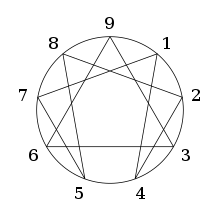Most certainly, you’ve heard of the Enneagram or perhaps been asked what type you are according to the Enneagram. It’s a well-liked personality test that may tell you a lot about who you are as a person both inside and outside of the office. The exam reveals the insecurities, motives, major personality traits, and fundamental values of your type.
What is the Enneagram?
According to the Enneagram, human personality is made up of nine different personality types that are interconnected. These nine categories are distinguished by a core assumption about how the universe functions. This idea thus exerts a dominant impact on our fundamental patterns of how we see the world and regulate our emotions. The Enneagram essentially assesses the influence of nurture on your personality.
Explaining the Enneagram Symbol
The Enneagram symbol has a long history, dating all the way back to Pythagoras’ writings. George Gurdjieff first introduced the sign, which Ichazo later explained.
The Enneagram is shown graphically as a circle with nine points surrounding it and arrows linking the points. The nine categories are represented by each of the numerals. The interconnectedness of the personality types is demonstrated by the lines.
Your personal progress is indicated by the black arrows in the diagram, while your stress is indicated by the red arrows. The upward direction of growth, which is good, shows your behavior while you are growing. It can specifically be interpreted as a direction of safety or possibilities. The direction of stress, in contrast, is seen negatively. It exposes your behavior in stressful or trying circumstances. It is believed to be your default setting when you are under a lot of stress, perhaps revealing bad tendencies.
The numbers next to your dominant type on the Enneagram diagram are another feature you may observe. Your Enneagram wings are referred to as these. Your wings, for instance, would be One and Eight if your kind were Nine. Which does this imply? You normally favor one of these wings over the other, and that wing is known as your dominant wing. Achieving harmony between the two wings is another option. Knowing about wings can help you better understand how other kinds affect you, as they have an impact on your type both favorably and adversely.
Additionally, the Enneagram is divided into the “triads” of the gut, head, and heart. Different manifestations of energy directed toward the designated bodily parts define these triads. Each triad’s core is comprised of three kinds Nine, Three, and Six, with the remaining types being variants of these cores. When we discuss the Enneagram types, we’ll delve a little more into them.
Origins of the Enneagram
It is generally disputed where the Enneagram came from and how it was created. Several ancient wisdom traditions have influenced the current Enneagram Personality Types. Aspects of several religions, including Buddhism, Hinduism, Judaism, and Christianity, are combined.
According to the Enneagram Institute, the system’s creator is widely regarded as Scar Ichazo. After traveling to Asia to establish his theories on self-realization, Bolivian philosopher and educator Ichazo founded the Arica School. He disseminated this information and examined his beliefs on the human mind and personality through the Arica School, which was founded in 1968.
Claudio Naranjo, a psychiatrist from Chile, is recognized as having introduced the Enneagram to modern psychology after studying Ichazo’s teachings. The idea and the nine kinds we use now were expanded by him. Since then, research on the Enneagram has benefited from numerous investigations and the use of other psychological theories, resulting in the widely used model we know today.
Additionally, the Enneagram continues to be studied and taught widely. In addition to the Arica Institute, several additional tools and services have emerged that might help you see the wider picture.
The Nine Enneagram Types
Type One: The Reformer
Being a One means you are conscientious, ethical, and possess a strong moral compass. You’re seen as being both logical and idealistic. Your drive to be right, to make things better, and to reach higher drives you.
Type Two: The Helper
People of Type Two are renowned for being truthful, supportive, kind, and amiable. If you fit this description, your motivations most likely stem from a need to be liked, valued, and able to communicate your sentiments to others.
Type Three: The Achiever
Threes are frequently confident, endearing, aspirational, and enthusiastic. If you are a Three, your motivations come from wanting to be validated, standing out from the crowd, and impressing or being respected by peers.
Type Four: The Individualist
This personality type is sensitive and contemplative. You typically have a self-aware, emotionally open, and private nature. The need to maintain one’s self-image and prioritize meeting their emotional needs are among the motivations.
Type Five: The Investigator
Fives are focused and intellectual. These characteristics include perceptiveness, secrecy, and insight. If this describes you, your motivation comes from a defensive need for information and having everything sorted out.
Type Six: The Loyalist
Being Six entails being devoted, security-conscious, diligent, and accountable. You’re skilled at fixing problems and have a tendency to be cautious. You are driven by a need for safety and validation.
Type Seven: The Enthusiast
Sevens tend to be active, impulsive, outgoing, and acquisitive. To retain your independence and pleasure, to keep yourself excited, and to stay out of difficult situations are what drive you.
Type Eight: The Challenger
Type Eight is strong and in command. Being self-assured, decisive, protective, and perhaps egotistical are traits of an Eight. Additionally, the desire to be independent, display your power, and maintain control over circumstances motivates you.
Type Nine: The Peacemaker
Being a Nine characterizes you as laid-back, humble, amiable, and upbeat. You tend to avoid confrontation, enjoy things going smoothly, and are driven to bring peace into your environment.
Based on the triads outlined above, all of them are divided into three broad types:
Types 1, 8, and 9 are gut (or body) types; they rely on innate intelligence and their “gut sensations” to deal with opportunities and hazards.
Heart types (Types 2, 3, and 4): People in this category navigate the world using their emotional intelligence.
Types 5, 6, and 7 are head types; they rely on their intellectual capacity to comprehend both themselves and others.
You may have a solid knowledge of your life’s principles by looking at these triads.
How the Enneagram Types are Measured
Statements make up the exam. You will grade each statement according to whether you believe it to be true, false, or true to your personality.
You will receive a visual chart and a summary of your results after responding to all the statements. It should be noted that according to the Enneagram system, each person is a unique synthesis of all nine types. The summary will therefore reveal your degree of each of the nine personality types as well as which one jumps out as being the truest to you.
The Enneagram in Everyday Life
Overall, it’s enjoyable and helps to understand your personality. In many facets of your personal and professional life, the Enneagram may be helpful.
Personal life
Knowing your Enneagram type can help you improve your emotional and cognitive abilities, which can be used to improve your lifetime learning. It may aid in giving you direction in a variety of ways, including your spirituality.
Furthermore, the Enneagram is crucial for enhancing communication in your interpersonal connections. It can improve relationships by assisting you with comprehending your own demands, fears, and strengths as well as those of your spouse or buddies. The Enneagram system may also reveal which other Types you get along with the most, either romantically or as friends. And lastly, it’s enjoyable! It may be a fantastic icebreaker or approach to get to know each other better to discuss the Enneagram and connect with people based on their type.
Professional life
For team building, effective communication, and leadership development in the workplace, more teams are turning to the Enneagram. The Enneagram may help you improve the way you interact with others at work, just like it can in your personal relationships. The Enneagram is also used in organizational psychology as a tool to boost worker productivity and motivation.
Benefits and Constraints of the Enneagram
Personality tests are a fun way to discover more about your personality, which is something you should want to do for a number of reasons. The ability to better understand your personality is the Enneagram’s biggest benefit, as was previously said. It encourages you to think about every question on the exam, which makes you more self-aware. Your own self-examination and investigation are aided by this. It also teaches you how to use your own characteristics to solve challenges in novel ways.
Any personality test has a self-reporting component, which is a drawback. Because test-takers are asked to evaluate themselves, the outcomes aren’t always reliable. They could be prejudiced or show the person as they wish to be rather than as they actually are.
The Enneagram is a pseudoscience, which is another major critique against it. Some consider it nebulous and hard to scientifically assess. The Enneagram should be viewed less as a psychological test and more as a whole personality assessment in light of this.




